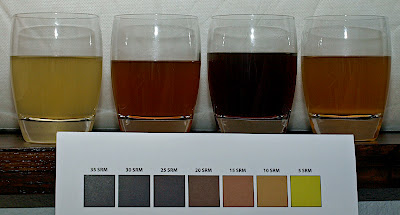My wife (along with about 1/150 people) has
Celiac, and as such, she can't have any gluten protein which you will find in such staples as Barley, Rye, (some) oats or Wheat (BRoW). One little problem for her though is that she's a fan of good beers. Since all normal beers have at least Barley or Wheat, then you can quickly see that beer is one of the many items that she can't have.
Well...almost. Essentially there is only 1 beer that is even slightly affordable in our area that is GF (
Redbridge), and it sucks at best. There is one other brand (
Green's), but they are about $5.50 for a bottle and can only be found at Whole Paycheck and Central Markup. There's actually one good and affordable GF beer (
New Grist), but you can't find it in our area.
The problem is that there hasn't been all that much work done on GF beers since they are much harder to make and the ingredients are more difficult to come by than normal beer ingredients. Also add to it that a lot of the beers try only 1or 2 ingredients and don't quite seem to find a balance of taste and body. Therefore, I have set out on a bit of a quest to take the time to malt and toast my own gluten-free grains and see what combination works best to create something that approximates what a beer should taste like.
Originally I created a beer for her that was a fantastic and flavorful version of a Belgian White (like Blue Moon). The results were fantastic, far beyond what I expected. Unfortunately though, I malted Quinoa, Millet & Soghum all together and wasn't really able to tell what flavors came from which grain. So, for my next batch I decided to be a bit more deliberate about the whole process and hope to do more experiments in the future which will help the gluten-free-beer-brewing public (yes, I know this is a fairly small sub-set of the world...but that sub-set has few resources).
So as the first part of this story, I will share the results of malting Red Quinoa, White Quinoa, and Millet. The results actually surprised me...
Below you will see the 4 glasses of liquid made by soaking malted and cracked grains in boiling hot water in my french press and then left to soak for about 20 minutes. This method works really well because you can easily strain out the grains and see what the resultant wort (baby beer) looks like.

From left to right:
- Unmalted Red Quinoa - Soaked in water for 2 hours, then toasted
Roasting: 1.5 hours in oven at 350 F
Color: 3-4 SRM
Smell: Light, nutty
Taste: Mild, nutty, watered-down
- Malted* Red Quinoa
Malting Time: 2 days
Roasting: 1.25 hours in oven at 350 F
Color: 15 SRM
Smell: Medium to full-bodied nutty smell, smells like non-GF wort with nuttiness
Taste: Slightly bitter, toasted-nutty, sour notes
- Malted White Quinoa
Malting Time: 2 days
Roasting: 1.25 hours in oven at 350 F
Color: 18-19 SRM
Smell: Roasted coffee, hints of roasted pumpkin seeds
Taste: Strong flavor, nice aftertaste...like coffee
- Malted Millet
Malting Time: 3 days
Roasting: 1.25 hours in oven at 350 F
Color: 10 SRM
Smell: Sweet and nutty, caramel tones
Taste: full-bodied, even tone, hints of lightly-burned popcorn (in a good way)
*Grains were malted by allowing them to soak in water for 3-4 days until sprouts were about 2x longer than the grain itself. Grains were rinsed 2x daily so as to avoid bacteria growth.
Lessons Learned:
- Despite what some books say, you simply cannot soak & toast a gluten-free grain. If you want ANYTHING to come out of your grain, then you will absolutely have to malt it.
- I thought red quinoa would have more color and flavor than white quinoa. Turns out, the exact opposite is true. White quinoa was darker, had more body and more flavor than either batch of red quinoa.
- The line between delicious caramel malt and a charred malt is only about 15 minutes. Next time I will pull the grains out earlier to try and get a more caramel-style malt.
- The white quinoa and millet taste much closer to a real wort than wort made with White Sorghum Extract by Briess. Sorghum tends to have strong sour notes, hence Redbridge tasting so bad.
- I still have much to learn.
I ended up using the white quinoa and millet for my next batch of gluten-free beer. They mashed really well (104-140-160 with 30 minute cycles) and the resultant wort was quite good. Not only that, but when I discarded the grains they smelled delicious...almost like a cup of hot chocolate...or a bowl of coco krispies. One thing to note is that there was a pretty high cold-break content compared to most normal beers that I've brewed. Overall I was pleasantly surprised by the initial product, but I will have to wait another month until I see if the resultant beer is any good. This batch will take a little longer since I'm going for a gluten-free trapist ale and it will have such a high alcohol content.
I think that's it for now. I'm currently playing with some Amaranth, Buckwheat and White Quinoa. Once I know more about the results, I'll post them here for reference.



